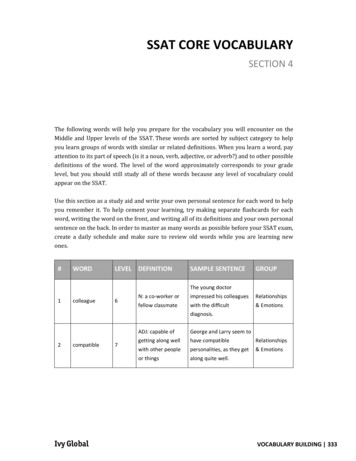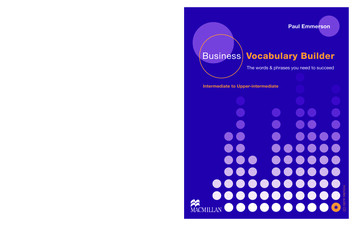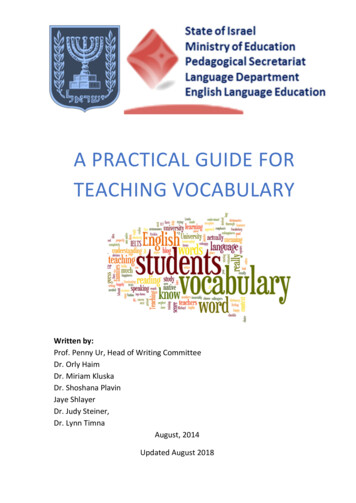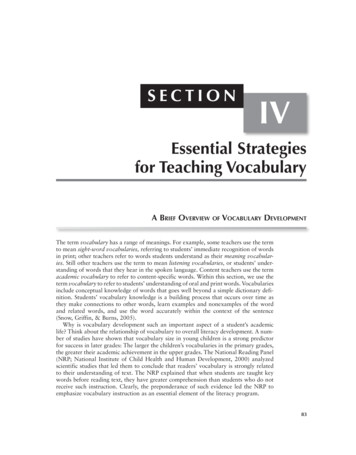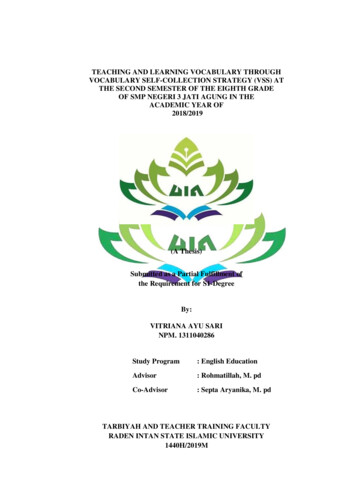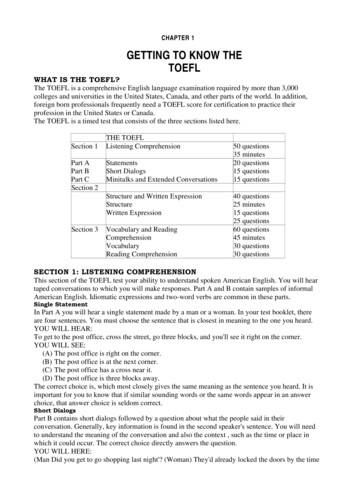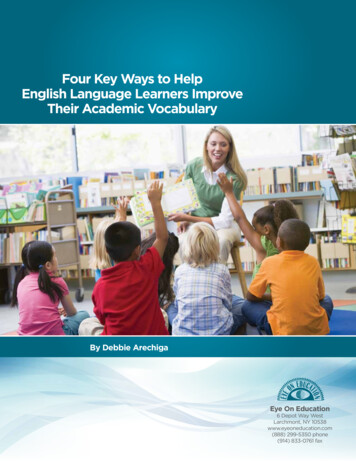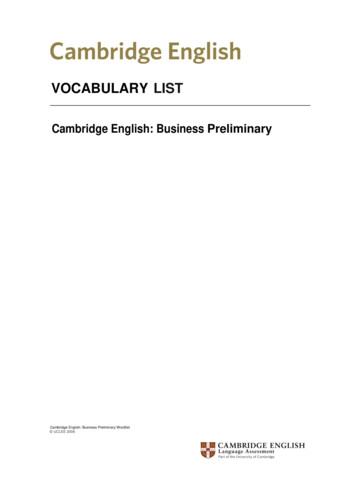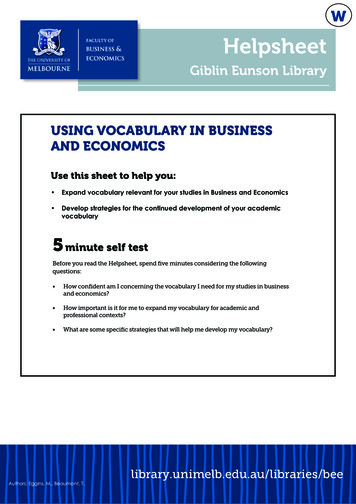
Transcription
THE EFFECTIVENESS OF TEACHING VOCABULARYBY USING PUPPET AT ELEMENTARY SCHOOLSTUDENTS(The Case study of the Fourth Graders of SDN Leteh II Rembangin the Academic Year of 2007/2008)a final projectsubmitted in a partial fulfillment of requirementsfor the degree of Sarjana Pendidikan in EnglishbySofika Chandra Nilawati2201403685ENGLISH DEPARTMENTFACULTY OF LANGUAGES AND ARTSSEMARANG STATE UNIVERSITY2009
PERNYATAANDengan ini saya,Nama: Sofika Chandra NilawatiNIM: 2201043685Jurusan/Prodi: Bahasa dan Sastra Inggris/Pendidikan Bahasa Inggris SIFakultas: Bahasa dan Seni UNNESMenyatakan dengan ini sesungguhnya bahwa skripsi/tugas akhir/final projectyang berjudul:THE EFFECTIVENESS OF TEACHING VOCABULARY BY USINGPUPPETS AT ELEMENTARY SCHOOL STUDENTS (The case of theFourth Graders of SDN Leteh II Rembang in the Academic Year of2007/2008) ACTION RESEACH. Yang saya tulis dalam memenuhi salahsatu syarat untuk memperoleh gelar sarjana ini benar-benar merupakan karyasaya sendiri, yang saya hasilkan setelah melalui penelitian, pembimbingan,diskusi dan pemaparan/ujian. Semua kutipan, baik yang langsung ataupunyang tidak langsung, baik yang diperoleh darisumber kepustakaan, wahanaelektronik, wawancara langsung, maupun sumber lainnya, telah disertaiketerangan mengenai identitas sumbernya dengan sebagaimana yang lazimdalam penulisan karya ilmiah. Dengan demikian, walaupun tim penguji danpembimbing penulisan skripsi/tugas akhir/final project ini membubuhkantanda tangan sebagai tanda keabsahannya, seluruh isis kaya ilmiah ini tetapmenjadi tangung jawab saya sendiri. Jika dikemudian hari ditemukanketidakbersan, saya bersedia menerima akibatnya. Demikian, harap pernytaanini dapat digunakan seperlunya.Semarang,Yang membuat pernyataan,Sofika Chnadra Nilawati2201403685ii
“Started with a dream, you can be what you want to be”“A Friend like a star, not always seen but always be there”(Free)To my adored parents,Bpk. Dirsun and Ibu Sriwahjuni;My Husband Ayom; andAll the members of H class inEnglish Department.iii
ACKNOWLEDGMENTAlhamdulillah, I wish to thank Allah the Almighty for the blessing, health,inspiration and ease blessed to me during the writing of the final project.I realize that many assistance and guidance from many people havecontributed to the writing of the final project. I would like to express my greatestgratitude and appreciation to my first advisor, Dra. C. Murni Wahyanti, M.A forinvaluable guidance, advice, suggestions and information in completing this finalproject. Then, I deeply indebted to my second advisor, Sri Wuli Fitriati, S.Pd,M.Pd, who has read the final project carefully and offered many valuablesuggestions and corrections for its improvement.Furthermore, my deepest gratitude is dedicated to A.R.Supadi, S.Pd theheadmaster of SDN Leteh II Rembang, who allowed me carrying out my researchin that school and also thank to the fourth grade students who happily sacrificedtheir time to participate in this study.My special thanks to all lecturers of the English Department of UNNESwho have taught me since the first year of my study.Sofika Chandra Nilawatiiv
ABSTRACTNilawati, Sofika Chandra. 2008. The Effectiveness of Teaching Vocabulary byUsingPuppet at Elementary School Students (The Case Study of the FourthGraders of SDN Leteh II Rembang in the Academic Year of2007/2008). A thesis, English Department, Faculty of Languages andArts, Semarang States University, Advisor 1) Dra. C. Murni Wahyanti,M.A, 2) Sri Wuli Fitriati, S.Pd. M.Pd.Key Words: vocabulary, elementary school students, a puppet, action research.This final project is an action research. In this study, I limit thediscussion by stating the following problem: “How is the students’ achievement inlearning English vocabulary by using a puppet?” The aims of the research is tofind out whether teaching vocabulary using puppet is effective to improve thestudents’ achievement. It is expected that the result of the study can enrich theteacher’s strategy in teaching vocabulary through puppets especially forelementary school students.The subject of the study was the students of SDN Leteh II Rembang inthe Academic Year 2007/2008. There were 46 students (24 boys and 22 girls).There were three steps in this action research. The first step of the activity was thepre-test. The second step of the activity was action which consisted of fouractivities. In the first activity, the teacher performed a puppet in front of the class.The theme of the first activity was fruits and animals. In the second activity, theteacher performed a puppet about road sign. In the third activity, the teacherperformed a puppet about parts of body. In the last activity, the teacher performeda puppet about things in the classroom. The third step of the activity was givingpost-test and answering questionnaire.Based on the data analysis, it can be seen that there is significantdifference in the result of the students’ pre-test and post-test. The averageachievement of the students’ pre-test was 56.63% and 96.19% in the post-test. Themain factor affecting this improvement was the students’ interest in the puppetgiven. It can be proved from the questionnaire results.Therefore, it can be suggested that the use of puppet can be analternative way to teach vocabulary, especially to improve the students’ masteryin vocabulary. This result hopefully would motivate language teachers to use apuppet in teaching English in the classroom, especially when teaching Englishvocabulary to elementary school students.v
TABLE OF CONTENTSPageAKNOWLEDGMENT ivABSTRACT . vTABLE OF CONTENTS . viLIST OF TABLES . ixLIST OF APPENDICES xCHAPTERI.INTODUCTION . 11.1General Background of the Study . . 11.2Reasons for Choosing the Topic . . 41.3Statement of the Problem . . . 51.4The Objective of the Study . . . 51.5Significance of the Study . 51.6The Outline of the Report . . 6II.REVIEW OF THE RELATED LITERATURE . . 72.1The Characteristic of Elementary School Students . . . 72.2General Concept of Vocabulary . . 82.2.1The Definition of Vocabulary . 82.2.2Teaching Vocabulary . 92.2.3Teaching Vocabulary to the Fourth Graderof Elementary School . . 12vi
2.3The Definition of Puppets . 132.3.1The Type of Puppets . . 142.4The Definition of Media . 162.4.1Puppet as Media in Teaching ElementarySchool students . . . 172.4.2The Techniques of Using Puppetin Teaching Vocabulary . 192.4.3The Procedures of Using Puppetin teaching Vocabulary . . 212.5Action Research . 22III.METHOD OF INVESTIAGTION . 263.1Subject of the Study 263.2Data Collection . 273.3Instrument of the Study 283.3.1A Puppet 283.3.2Tests . 283.3.3Field Notes 293.3.4Questionnaire . . 293.4The Steps in Action Research . 303.5The Criterion of the Assessment . 333.6Data Processing 33vii
IV.DATA ANALYSIS . 344.1Description of the Result . . 344.1.1The Analysis of the Pre-Test . . 354.1.2The Analysis of the Action . . 374.1.3The Analysis of the First Activity . 374.1.3.1 The Analysis of the Second Activity . 404.1.3.2 The Analysis of the Third Activity . . 434.1.3.3 The Analysis of the Fourth Activity . 464.1.4The Analysis of the Post-Test . 484.1.5Analysis of the Field Notes . 524.1.6Analysis of the Questionnaire . . . 53V.CONCLUSIONS AND SUGGESTIONS5.1Conclusions . 565.2Suggestions . 57REFERENCES . 58APPENDICES 60viii
LIST OF TABLESTablePage1. The Result of the Pre-test 352. The Result of the Students’ Achievement in the First Activity . 383. The Result of the Students’ Achievement in the Second Activity . 414. The Result of the Students’ Achievement in the Third Activity . 445. The Result of the Students’ Achievement in the Fourth Activity . 476. The Result of the Pre-test 487. The Result of the Tests during the Action Research 508. The Result of the Questionnaire the Action Research . . 55ix
LIST OF APPENDICESAppendixPage1. List of the Action Research Students . 602. Instrument of Pre-Test . 613. Answer Key of the Pre-Test . 674. The Score Analysis of the Pre-Test 685. The Score Analysis of the Post-Test . 706. Questionnaire . 727. The Analysis of the Questionnaire . 738. Rencana Pelaksanaan Pembelajaran . 74x
CHAPTER IINTRODUCTION1.1Background of the StudyEnglish as an international language is used in countries throughout theworld, including Indonesia. Last few years, English has been taught at elementaryschool. It has been accepted in Indonesia in line with the government’s plan on thenine-year compulsory study. Based on the 1994 curriculum, English at elementaryschool level is taught as local content to serve the need of the local community. Atthis level students learn English for the first time, so they just learn the simpleEnglish patterns including vocabulary, grammar, etc. The program begins fromthe fourth grade till the sixth grade. The aim is to equip students with the ability tolisten, speak, read, and write simple materials in English by emphasizing on thecommunicative skills in a number of topics which are relevant to the need of localcommunity, such as, industry, tourism, and arts in Central Java (GBPP Mulok SD,1995:2).Teaching for students of elementary school is not the same as teachingadult because they have different characteristics and motivation. They aredifferent from adults, so the way of teaching must be different too. According toScoot (1990: 2-4) there are some general characteristic of the children in thatgroup (a) they are competent user of mother tongue, (b) they can tell thedifference between fact and fiction,1
2(c) they love to play and learn best when they enjoy themselves seriously and liketo think that what they are doing in real work., (d) they are enthusiastic andpositive thinking, (e) they rely on the spoken as well as the physical words toconvey and understanding meaning, (f) They are able to work with others andlearn from others, (g) their own understanding comes trough eyes, hands and ears,(h) they have very short attention and concentration.If the teachers can not teach the children properly, the children may notenjoy their learning. Consequently, the teaching learning process may fail.Elementary school teachers need appropriate methods to teach thestudents. The proportions of the materials for young learners are different fromthat of the adult learners. Generally that teaching material emphasize on the abilityto enrich their vocabulary of English language. The way of teaching vocabulary isnot the same as teaching vocabulary to adult learners. They have differentmotivation and characteristic. It will be difficult when the teacher can notmotivate young learners intensively. Through motivation from their teacher it willincrease their interest to learn better, so the students’ interest in learning will besame as their interest in playing. To find out the best technique for teaching younglearners need an intensive analysis, especially for the teacher. They should createalternative of techniques to teach young learners in order to make them interestedto what they are going to learn and avoid boredom.According to Harris (1969:345) there are several methods in Englishlearning process. They are (a) giving total physical activity (example games andTotal Physical Response activities), (b) providing hands on activities (example to
3learn words, sentences, and practice meaningful language), (c) internalizingconcept through visual aids (example video, picture, tapes, music, flash card, andpuppet toys), and (d) explaining things with nonverbal language (facial features,gestures). Helalay (1971:1) argues that:Unlike adults, children are not self-motivated and do not havean immediate need to learn English. They are not concern withjob or university degree that requires knowledge of English.Their daily games, events, of interest to them, new knowledgemay ask.There are several media of teaching. Gerlach and Elly (1980: 247-249)classify them in to six general categories. They are still pictures, audio recording,motion pictures, television, real things simulation and models, programmed andcomputers-assisted instruction programs.Media such as puppets, cartoon films, tape recorder, radio, television,computer, etc. are useful to achieve the instructional goals of teaching andlearning process, and they can also be easily found in our daily lives. Havingunderstood that young learners pay short attention and concentration in a learningprocess, it is better to provide something playful to them. In this study, the writertries to use puppet toys, for teaching English vocabulary to elementary schoolstudents.Using the puppet as an alternative medium of teaching young learnerscould be considered as the best way since it pleases them a lot. Furthermore, it is aprecious resource to develop students’ abilities in listening, speaking, reading, andwriting. The writer is interested in using the puppet in order to enrich and improvethe mastery of the students’ vocabulary. By using this media, it is hoped that the
4students can enjoy the teaching and learning process and can memorize the wordseasily.There are several previous studies written by the students of EnglishDepartment of UNNES. One of was them entitled “The use of Puppet toys as themedia to teach vocabulary to fourth grade students of SDN 1 Bandar Batang”written by Wasana Sindu Wibowo (2001). He used puppet toys to teachvocabulary to elementary school students. He observed the puppet in teachingvocabulary. He wanted to find out the extent of students’ achievement invocabulary mastery by the use of the puppet in teaching. He gave some treatmentsto students during the teaching-learning process. The result was that using thepuppet to teach vocabulary to the elementary school students is very beneficial forthe students.Based on that research, the writer was curious to use puppet as mediumin teaching learning process. Hence, in this study the writer wants to examine “theeffectiveness of teaching vocabulary by using puppet at elementary school (for thefourth graders of SDN Leteh II Rembang in the academic year 2007/2008). Thewriter wants to analyze whether teaching vocabulary by using the puppet is moreeffective to improve the students’ achievement in vocabulary.1.2Reasons for Choosing TopicSome reasons why the writer chooses the topic “The Effectiveness ofTeaching Vocabulary by Using Puppets at Elementary School Students” are:(1)Vocabulary is basic component in learning a foreign language.
5(2)Generally children like puppets, so they are highly motivated to learnvocabulary and to memorize words that the children watch from puppetperformance. Furthermore, puppet will make the students relaxed and fun.1.3Statement of ProblemThe problem investigated is stated as follows:How is the students’ achievement in learning English vocabulary byusing a puppet?1.4Objective of StudyThe aim of this action research is to find out whether teachingvocabulary using a puppet is effective to improve the students’ achievement.1.5Significance of StudyOn basis of the objective above, the significance of the study can bestated as follows:(1)For the students, teaching vocabulary by using puppet can motivate thestudents in order to be more interested in learning vocabulary.(2)For the teacher, to provide the better technique for teaching vocabularyin elementary class.(3)The writer hopes that the result of the research can be used as referencefor those who want to conduct a research in teaching English.
61.6Outline of The ReportThe writer organizes this research report in order to make the readereasier to understand. The following shows the content covered in this research.Chapter I is introduction. This chapter explains about generalbackground of the study, reasons for choosing the topic, statement of problem,objective of study, significance of study, and the outline of report.Chapter II presents review of related literature. It covers thecharacteristic of elementary school students, general concept of vocabulary, thedefinition of puppets, the definition of media, and action research.Chapter III discusses the method of investigation, which consists ofsubject of the study, data collection, instrument of study, the steps in actionresearch, the criterion of the assessment and data processing.Chapter IV discusses the analysis of the research.The final chapter is chapter V that draws some conclusion andsuggestions.
CHAPTER IIREVIEW OF RELATED LITERATUREThis chapter covers the characteristic of elementary school students,general concept of vocabulary, the definition of puppets, the definition of media,and action research.2.1Characteristics of Elementary School StudentsDealing with the development of curriculum in Indonesia, teachingEnglish to young learners has become important in recent years. However, it is notalways an easy task to teach young learner. There are many considerations thatshould be taken on how to teach and what to teach. It is fact that children aredifferent from adult physically and mentally.The age has become a major factor to formulate decisions on teachingstudents. The students who are considered as young learners enjoy studyinglanguage through loads of cheerful activities in a bright and colorful room. Whileadult are expected to use abstract notions since they can think rationally. AsHarmer (2001:40) affirms that adults often encompass clear understanding of whythey are learning and what they wish to comprehend out of it.Teaching elementary school students is not the same as teaching adultbecause it possess different characteristic as maintained by Helay (1987:49):Unlike adults, children are not self-motivated and do not have animmediate need to learn English. They are not concerned with job or7
8university degree that requires knowledge of English. Their world istheir daily games, events of interest to them, new knowledge that maycome across and question that their inquisition minds may ask.In general, the elementary school students are the children at the agebetween six up to twelve years old which are enthusiastic to know and learneverything. Harmer (2001: 38) states some general characteristic of children.There are (a) they respond to meaning even if they do not understand the words,(b) they often learn indirectly than directly, (c) their understanding comes not justfrom the explanation, but also from what they see hear and crucially have achance to touch and interact with, (d) they generally display an enthusiasm forlearning and curiosity about the world around them, (e) They have a need forindividual attention and approval from their teacher, (f) they are taken on talkingabout themselves and responding well to learning that use themselves and theirown lives as main topic in the classroom, (g) They have limited attention span,unless activities are extremely engaging can make them easily getting bored,losing interaction after 10 minutes or so.Based on the points stated by Harmer above, I assume that elementaryschool students are very enthusiastic in finding out, understanding and learningeverything.2.2General Concept of Vocabulary2.2.1Definition of VocabularyVocabulary is one of the materials studied by students of all level ofschools in Indonesia. It has been mastered if they want to master English well. It
9is impossible to be successful in study language without mastering the vocabulary.Vocabulary is a central of language and of critical importance of typical language.Without sufficient vocabulary, people can not communicate effectively or expresshis ideas in both oral and written form. To support the speaker’s interaction incommunication, vocabulary becomes important because it can be used as basicfoundation to construct a word into a good sequence of sentence. Therefore, thestudents should have to obtain vocabulary mastery. Hocket (in Celce-Murcia andMc Intosh, 1978: 129) states that vocabulary is the easiest aspect at a secondlanguage to learn and it hardly requires formal attention in the classroom. Hornby(1995: 1331) defines “vocabulary as a list of words used in book, etc. usually withdefinition and translation”.According to Finnochiaro (1974: 73) there are two kinds of vocabulary,namely active vocabulary and passive vocabulary. Active vocabulary refers to thewords the student understands, can pronounce correctly and use themconstructively in speaking and writing. On the other hand, passive vocabularyrefers to the words in which the students can recognize and understand while theyare reading or listening to someone speaking, but they do not use the words inspeaking or in writing.Based on the definition above, I conclude that the more vocabulary thelearners have, the easier for them to develop their four skills (listening, reading,writing, and speaking) and learn English as the foreign language generally.
102.2.2Teaching VocabularyVocabulary is very important for second language learners; only withsufficient vocabulary learners can effectively express their ideas both in oral andwritten form. Thus they should have a good idea of how to expand theirvocabulary so that they can improve their interest in leaning the language.Language teachers, therefore, should posses considerable knowledge on how tomanage an interesting classroom so that the learners can gain a great success intheir vocabulary learning.Teaching vocabulary plays an important role in language acquisitionbecause the mastery of vocabulary will help students to master all the languageskills; speaking; listening; writing; and reading. The vocabulary will make thestudents practice life and will strengthen belief that English can be used to expressthe same ideas or feeling they express in their native language (Finochiaro,1974:38)Furthermore, in teaching vocabulary the teacher can introduce the list ofvocabulary that is taken from the book. The teacher uses and adds othervocabulary which is relevant to the students. Teacher needs a good knowledge ontheir teaching materials. When they have to teach the students about vocabulary,teachers should know the general knowledge of vocabulary, words and also themeaning. The words or vocabulary can be spoken and written.Wallace (1982:207) explains that teaching vocabulary should considerthese following factors:
111) AimsThe aim of teaching vocabulary is to make the teacher easy to formulate thematerials, which will be taught to the students.2) QuantityThe teacher has to decide the number of vocabulary items to be learned. Thelearners will get confuse or discouraged if they get many new words.Therefore, the teacher should select new words, which can easy to understandby the learners.3) NeedIn teaching vocabulary, the teacher has to choose the words really needed bythe students in communication.4) Frequent exposure and repetitionFrequent exposure and repetition here means that the teacher should givemuch practice on repetition so that the students master the target words well.They also give opportunity to the students to use words in writing orspeaking.5) Meaningful presentationIn teaching vocabulary the teacher should present target words in such a waythat the meaning of the target words are perfectly clear and unambiguous.6) Situation and presentationThe teachers tell the students that they have to use the words appropriately.The use of words depends on the situation in which they are used anddepends on the person to whom they are speaking.
12From the expalnation above I conclude that the teachers must know thedifferent kinds of vocabulary. In addition, understanding the above factors is veryimportant for the teacher before teaching vocabulary to elementary Elementary SchoolTeaching English to elementary school students as a local content has agoal that the students are expected to have skills of the language in simple Englishwith emphasis on listening, writing, reading and speaking skill using selectedtopics related to their environmental needs.Related to the objective above, the material for the fourth grade, havetopics about center of interest that they often face in their life. The topics includethings inside a class and things around a school. So, it is easier for them toperform and absorb the words given which are about things inside the class andthings around the school.There is no basic rule on how many words should be given to the fourthgraders of elementary school. As ten up eleven years old children, the fourthgraders should not be given too many words. It is better to give them about sevenor eight new words at one time.To help the learners in learning foreign language Mary Slaterry and JaneWilis (2003: 4) suggest some ways to teach them. There are (a) make learningEnglish enjoyable and fun, (b) don’t worry about mistake, be encouraging; makesure children feel comfortable and not afraid to take part, (c) use a lot of gestures,
13action, pictures to demonstrate what you mean, (d) talk a lot to them use English,especially about things they can see, (e) play game, sing a song, and say rhymesand chants together, (f) tell simple stories in English, using pictures and actingwith different voices, (g) don’t worry when they use their mother tongue. You cananswer a mother tongue question in English and sometimes recast in English whatthey say in their mother tongue, (h) Consistently recycle new language but don’tbe afraid to add new things or to use words they won’t to know, (j) plan lessonwith varied activities, some quite, some noisy, some sitting, some standing andmoving.From the explanation above, I conclude that in teaching vocabulary tothe fourth graders, teacher should not give the students too many new words in alesson. It is better to give them about seven or eight new words rather than givingthem many words. It is better to practice the words given in order to achievecomprehension. Few words would help them memorizing the words quickly andto internalize them.2.3Definition of PuppetsGwin (1972: 60) states that puppet is a wonderful toy that can becontrolled by an operator and can teach kids and adult, all kinds of things.It is defined by Reyhmer (1997: 339) that a doll with a hollow head aperson or animal and cloth body, intended to fit over the hand be manipulatedwith the fingers. While based on Oxford dictionary (1974: 679) puppet is definedas doll small figure of animal etc, with jointed limbs by wire or strings used in
14plays or doll of which the body can be put in the hand like a glove the arms andhead being moved by the fingers on the operation.From the definition above, it can be concluded that puppets are parts ofvisual aid for teaching strategies especially in teaching vocabulary. It is believedthat puppet can give an element of fun to learners. By inserting humorouselements, puppets are intended to attract the student’s attention.2.3.1The Type of PuppetsAs an educational tool, puppets have become very widely acceptedbecause of their value in helping students in personal development and theopportunity afforded in activity in the building and operating puppets.In teaching using puppet as a media, it will be better to take the availablematerials. Teaching using puppet can be used as the alternatives technique inteaching learning process. It is good to know a number of ways to make puppetsso that they can be used at different levels without repeating some types andmethods of approach.According to Lewis (1973: 364) the commonly used puppets are:(1) Hand puppetsIt generally consists of a head figure and loose garment or dressed fittedover the operator’s hand. The garment covers the operator’s wrist and helpsto hide it from views. The index finger fits into the puppets head and thethumb and middle finger slide into tiny sleeves to form two movable arms.The hand puppet is operated below the puppet stages.
15(2) Glove and Finger puppetsIt makes use of gloves to which small costumed figures are attached. Theoperator uses the index and middle fingers as puppet legs. Puppet bodies canbe either flat cutouts or doll like figure. These puppets are operated from theback of the stage.(3) Rod puppetsIt usually has jointed bodies made with stiff wire, umbrella ribs, or thinwooden sticks attached to arms, legs or heads. Rods can also be used to pushanimal cutouts, stage furniture or scenery on or the stage or to move the rodpuppets while on stage.(4) MarionettesMarionettes are flexible, jointed puppets operated by strings or wire attachedto a crossbar and maneuvered from directly above the stage. Although theycan be almost any size, they are usually between 10 and 24 inches in length.Weight placed in their feet help to keep them upright and in proper workingcondition. Marionettes are considerably more complicated than puppet tomake and to operate.(5) Shadow puppetsShadow puppets are usually formed from a piece of thin card board or wood,to which handles are attracted to permit manipulation behind a
learning English vocabulary by using a puppet?” The aims of the research is to find out whether teaching vocabulary using puppet is effective to improve the students’ achievement. It is expected that the result of the study can enrich the teacher’s strategy in teaching vocabulary t
